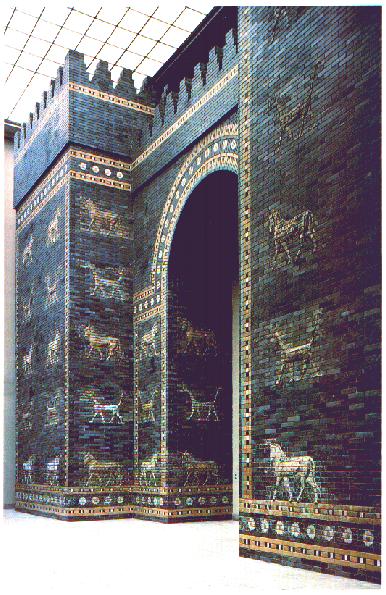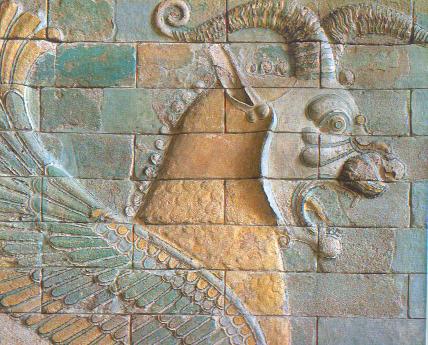
The famous gate of Ishtar of Babylon, by R. Koldewey.
| The Beginnings of ASSYRIA and BABYLONIA |
UR , which had annexed the towns of Suse and Assur had just fallen in 2004 BC. The Elamites had burned the city, and then installed a garrison there. It was overpowered, and they were driven out in 1998 BC by those who should have saved it, the perjuror ISBI-ERRA, who then annexed UR with its kingdom of Isin.On his arrival, Isbi-Erra started by rebuilding the city and the ruined temples of UR. Then he declared himself " KING of Ur, Sumer and Akkad." There were three more dynasties to exert power over Mesopotamia while waiting for the birth of a new kingdom, the future Great " Babylon "...
The Dynasty of Isin |
The Dynasty of Larsa |
The Dynasty of Assyria |
ISBI-ERRA 2017 to 1985BC |
EMISUM reigned 2004 to 1977BC |
PUZUR-ASHUR 1st |
IDDIN-DAGAN 1974 to 1954BC |
SAMIUM 1976 to 1942BC |
SHALLIM-AHHe |
ISHME-DAGAN 1953 to 1935BC |
ZABAIA 1941 to 1933BC |
ILUSHUMA |
LIPIT-ISHTAR reigned
|
GUNGUNUM reigned
|
ERIKSHUM 1st |
The children of Isbi-Erra worshiped DAGAN, the god of corn, venerated with Mari and Ebla.Lipit Ishtar was also the author of a code of Justice of forty articles, (which preceded that of Hammurabi), but at the end of his reign he was conquered by GUNGUNUM, king of Larsa, who took the towns of Ur, Suse and Lagash.
In 1900BC, terrible disorder broke out, and the Bedouins infiltrated the country of Sumer. These AMORITE (Syrian) tribes benefitted from the wars in that they gained the kingdoms ofIsin and Larsa, and seized the towns of Ilip, Marad, Malgûm, Mashkan-shapir and Uruk...
In 1894 BC, an Amorite prince called SUMU-ABUM took advantage of the anarchy and settled in a small town of no importance political importance named "Babilim", which in Akkadian means " Lhas gate of the god", and in Greek " BABYLON". Not to draw attention to himself, he continued the worship of a small local god, a secondary divinity of the family of Enki, named MARDUK (or Amar UTU), the servant of the protective god Shamash, son of Sippar. Marduk was soon going to replace the great god ENLIL , and become the god of power, war, sex and domination!
Kingdom of Isin |
Kingdom of Larsa |
Kingdom of Babylon |
DAMIK ILISHU |
RiM SiM |
Sin Muballit |
HAMMURABI : King of BABYLON from 1792 to 1750 BC
Hammurabi seized Isin, Uruk, Ur (1787BC), Malgum (1784BC), and Larsa (1763BC)! Then came the fall of Mari and its king Zirim Lin, who revolted against Hammurabi. The ramparts of Mari were torn down along with the palace, and thus the great capital was completely destroyed in (1759BC). During a flood in 1756BC, Hammurabi consolidated his transitory empire and descended on the town of Assur...HAMMURABI ruled with exceptional wisdom, protecting the poor, the widows and orphans, and in this man (who paid homage to the goddess Ishtar ,) one finds already a hint of the laws that Moses would give his people on leaving Egypt:
- "I proclaim the right in the Country to eliminate the bad and the perverted, so that the strong do not oppress the weak. I want to be to the people like the sun, illuminating all the country, and giving happiness. I am the Savior whose sceptre is justice, giving benefit to all in the city. Thanks to tea protective Isthar goddess, they thrived and thanks to my wisdom, I sheltered them...
One knows very little about the priestesses of Ishtar; some regard them as very liberated women or as very rich businesswomen who bought and rented houses, vines and land. Others believe them to have been priestesses, singing hymns to the gods and giving them the sacrifices offered by the people. Sometimes people haunted by cruel demons were brought to them for healing and exorcising. They could even marry if they wished.

The famous gate of Ishtar of Babylon, by R. Koldewey.
The expansion of
BABYLON
and the attacks
on the tower of
Babel
There were at the time of Nabuchadnesor II, (604 to 582BC) in Babylon approximately "1, 200 temples and vaults" over an area of 850 hectares. "Babylon the Great" was well fortified, with eight access portals. Each of these gates was dedicated to a god or a protective goddess; the principal gate was dedicated to the goddess Ishtar, it was 25 meters high and had no less than 150 figures of dragons and bulls drawn and carved in relief. According to Herodotus, four sets of riders could pass each other on top of these walls without touching each other!From this principal gate began the "Great Royal Way", which was a large avenue twenty meters wide, entirely paved in limestone flagstones and flanked by large, thick walls. This avenue crossed all the city, leading directly to the central ziggurat: the famous "TOWER OF BABEL", probably built under king Hammurabi , who had also just built his large palace opposite the huge brick temple.
Built in the manner of the large step pyramids , this immense square construction, each side 90 meters high, had seven floors. Each floor was connected to the next by elegant external staircases, giving access to the "900 vaults", of which 600 were dedicated to the celestial gods and 300 to the terrestrial divinities! They were richly decorated with precious stones and there were many statues carved out of rare stones, gold, bronze or wood from the cedars of Lebanon.

Griffon of Babylon.
The Babylonians called this huge tower "Etemeanki", which means "the temple connecting the sky and earth...."According to Herodotus, the top floor was forbidden to pilgrims, and no statues were allowed there. It was empty, except for a bed and a table in solid gold, reserved for the national god Marduk, so that he could stay there each time he returned to Earth.
When the Jews were exiled in Babylon under Nabuchadnesor II, (who had burned and destroyed their temple of Solomon), they regarded this tower as a provocation and cursed it; all the men who had built it would be unable to comprehend languages, and without completing it (!).
The tower was partially destroyed by the Assyrian Sennacherib (704 to 681BC), but was rebuilt by the Assyrian Assarhadon (680 to 669BC) and his son Assurbanipal (688 to 627BC). It was entirely restored by Nabopololassar and his son Nabuchadnesor II (604 to 562BC), employing many slaves, (and in particular Jews). Despite the fact that Nabuchadnesor had destroyed their temple, they were forced to rebuild the Old Tower of Babel! Fortunately their slavery ceased in 539BC, when Babylon was taken by the Persian king Cyrus.
The Tower of Babel was again destroyed into 479BC by Xerxes 1st (485 to 465BC). It has completely disappeared now, except for the ditch dug by the plunderers around the foundations to extract the last bricks. Even though Alexander the Great used more than 300,000 slaves, he gave up the idea of much of the work of restoration.
But Babylon also had another treasure which appeared among the "seven wonders of the world," this being the famous : "Hanging gardens of Babylon" where the most beautiful plants of the East grew. An irrigation system of fountains fed all the flowering plants. It was like a mirage in the desert, where one could believe that a fine rain was always falling from the sky on to a corner of paradise !
The Birth of the Hittite Empire
Towards 1650BC, a first wave of Indo-Europeans arrived from the Balkans and settled in Anatolia (currently Turkey). An intelligent people, they already had mastered the techniques of using iron, of raising horses and using tanks. Hattousil 1st called his new capital "Hattusas or Hattousas".Even though the Hittites gave little importance to religion, they adopted INDRA, theVedic god of lightning , adding their own sun god, MITRA. As in Egypt, their king was both the Supreme Judge and High Priest.
The Height of the Hittite empire |
| Around
1620 BC, Hattousil 1st disowned his nephew and named
his grandson Moursil as his successor. |
|
From 1620 to 1590 BC, Mursil
1st reigned. He ransacked and destroyed the
town of
Alep in Syria, and then in 1595 BC seized the ramparts of Babylon, terrifying the inhabitants. He set out again, carrying away the large gold statue of Marduk. |
| At about 1590 BC, Hantili succeeded Moursil 1st. |
| From 1530
to 1500 BC, Telepinou reigned. A new kingdom of
Mitanni (the former Hourrites) had been created in 1560BC. It started by overpowering and occupying Armenia, then Syria and Assyria (in 1460BC). Mitanni is located below Armenia, north of the Tigris and the Euphrates. |
| In 1480 BC,
the Gasgas Barbarians invaded the Hittite empire during the reign of Tudhalia
II |
| In about 1385 BC,
SUPPILULIUMA 1st seized power and pushed back the invasion of the
terrible Gasgas. He annexed Lebanon and Northern Syria, (Karkemish). He made vassals of Amourrou and Mitanni, where he placed on the throne an exiled prince Mattiwasa. The Egyptian king Akhenaton preferred peace, leaving king Doushratta (Tuhsratta) to drive back the invaders. Drunk with success, the proud Suppilulima was named the "Sun king". |
| About 1365
BC, the Mitannian king Tushratta died whilst besieged
in his capital Wasukana, preferring suicide to torture by the Assyrians. |
| In 1350 BC, Mursil
II succeeded Suppiluliuma, his empire extending from the Black Sea in Syria, and he was able to subjugate the kingdom of Mitanni, so coveted by the Assyrians. |
| At about 1340 BC,
the widow of the Egyptian king Toutankhamon asked the Hittite king to send his son to be her husband. The young Hittite prince was to be assassinated on his journey there... |
| In 1315 BC, the Hittite Muwatali succeeded Moursil II. |
| About 1295 BC, There
was the battle of Kadesh, between Ramses II and the Hittite king "Muwatali " who invaded and ransacked the Egyptian camp.The Canaanites revolted against Egypt. |
| In 1290 BC, Muwatali
died, and there ensued a crisis of succession. Ramses II profited from this
and again took Canaan and part of Syria. |
| About 1282 BC,
HATTUSIL III deposed his brother UHRI-TESHUB, and negotiated
in 1278 BC a Egypto-Hittite treaty with Ramses II, sharing Syria and Lebanon between them. This peace would last 40 years... |
| Around 1200
BC, the people of the Sea (Mouskis, the cruel Arameans along
with the Gasgas and Phrygians) destroyed Anatolia and the capital Hattousha, (this was the end of the Hittite Empire). |
| In 1193BC and 1188
BC, Ramses III conducted several campaigns to keep back
the invaders, some of whom were to become the Philistines, who settled along the coastal shores of the Mediterranean. |
| The Middle East in 1300BC |
